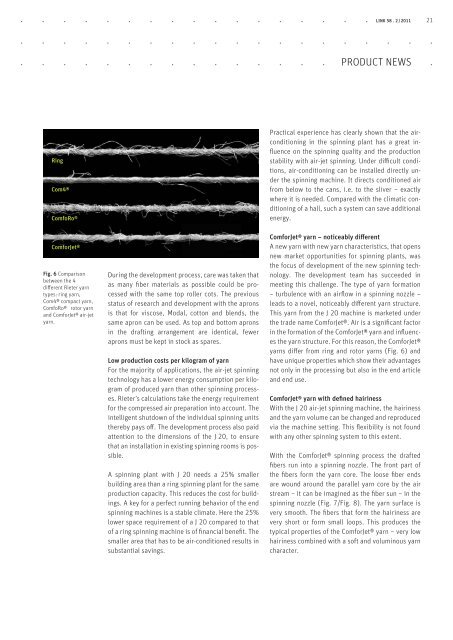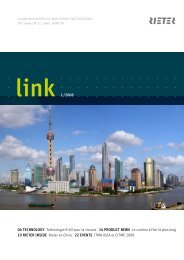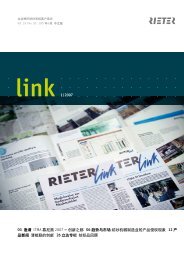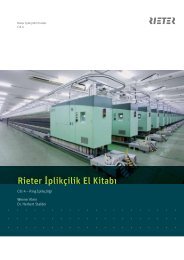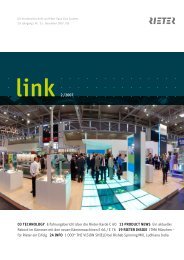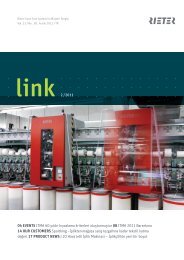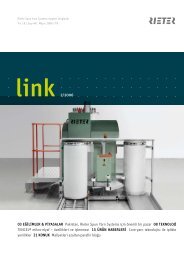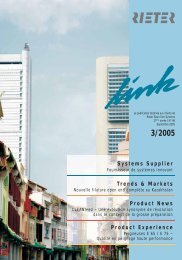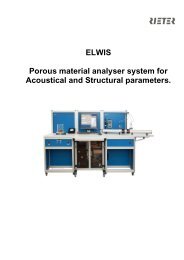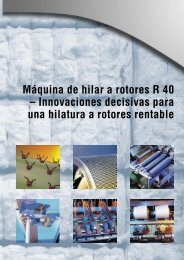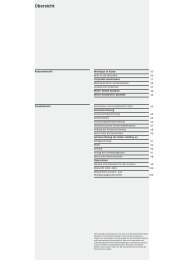Download LINK - Rieter
Download LINK - Rieter
Download LINK - Rieter
You also want an ePaper? Increase the reach of your titles
YUMPU automatically turns print PDFs into web optimized ePapers that Google loves.
Ring<br />
Com4®<br />
ComfoRo®<br />
ComforJet®<br />
Fig. 6 Comparison<br />
between the 4<br />
different <strong>Rieter</strong> yarn<br />
types: ring yarn,<br />
Com4® compact yarn,<br />
ComfoRo® rotor yarn<br />
and ComforJet® air-jet<br />
yarn.<br />
During the development process, care was taken that<br />
as many fiber materials as possible could be processed<br />
with the same top roller cots. The previous<br />
status of research and development with the aprons<br />
is that for viscose, Modal, cotton and blends, the<br />
same apron can be used. As top and bottom aprons<br />
in the drafting arrangement are identical, fewer<br />
aprons must be kept in stock as spares.<br />
Low production costs per kilogram of yarn<br />
For the majority of applications, the air-jet spinning<br />
technology has a lower energy consumption per kilogram<br />
of produced yarn than other spinning processes.<br />
<strong>Rieter</strong>’s calculations take the energy requirement<br />
for the compressed air preparation into account. The<br />
intelligent shutdown of the individual spinning units<br />
thereby pays off. The development process also paid<br />
attention to the dimensions of the J 20, to ensure<br />
that an installation in existing spinning rooms is possible.<br />
A spinning plant with J 20 needs a 25% smaller<br />
building area than a ring spinning plant for the same<br />
production capacity. This reduces the cost for buildings.<br />
A key for a perfect running behavior of the end<br />
spinning machines is a stable climate. Here the 25%<br />
lower space requirement of a J 20 compared to that<br />
of a ring spinning machine is of financial benefit. The<br />
smaller area that has to be air-conditioned results in<br />
substantial savings.<br />
<strong>LINK</strong> 58 . 2 /2011<br />
PRODUCT NEWS<br />
Practical experience has clearly shown that the airconditioning<br />
in the spinning plant has a great influence<br />
on the spinning quality and the production<br />
stability with air-jet spinning. Under difficult conditions,<br />
air-conditioning can be installed directly under<br />
the spinning machine. It directs conditioned air<br />
from below to the cans, i.e. to the sliver – exactly<br />
where it is needed. Compared with the climatic conditioning<br />
of a hall, such a system can save additional<br />
energy.<br />
ComforJet® yarn – noticeably different<br />
A new yarn with new yarn characteristics, that opens<br />
new market opportunities for spinning plants, was<br />
the focus of development of the new spinning technology.<br />
The development team has succeeded in<br />
meeting this challenge. The type of yarn formation<br />
– turbulence with an airflow in a spinning nozzle –<br />
leads to a novel, noticeably different yarn structure.<br />
This yarn from the J 20 machine is marketed under<br />
the trade name ComforJet®. Air is a significant factor<br />
in the formation of the ComforJet® yarn and influences<br />
the yarn structure. For this reason, the ComforJet®<br />
yarns differ from ring and rotor yarns (Fig. 6) and<br />
have unique properties which show their advantages<br />
not only in the processing but also in the end article<br />
and end use.<br />
ComforJet® yarn with defined hairiness<br />
With the J 20 air-jet spinning machine, the hairiness<br />
and the yarn volume can be changed and reproduced<br />
via the machine setting. This flexibility is not found<br />
with any other spinning system to this extent.<br />
With the ComforJet® spinning process the drafted<br />
fibers run into a spinning nozzle. The front part of<br />
the fibers form the yarn core. The loose fiber ends<br />
are wound around the parallel yarn core by the air<br />
stream – it can be imagined as the fiber sun – in the<br />
spinning nozzle (Fig. 7/Fig. 8). The yarn surface is<br />
very smooth. The fibers that form the hairiness are<br />
very short or form small loops. This produces the<br />
typical properties of the ComforJet® yarn – very low<br />
hairiness combined with a soft and voluminous yarn<br />
character.<br />
21


